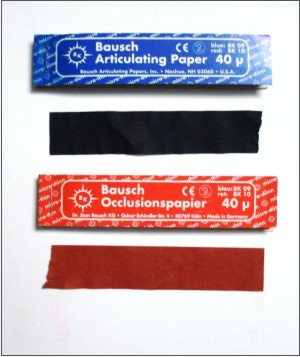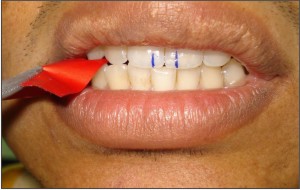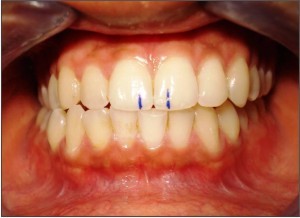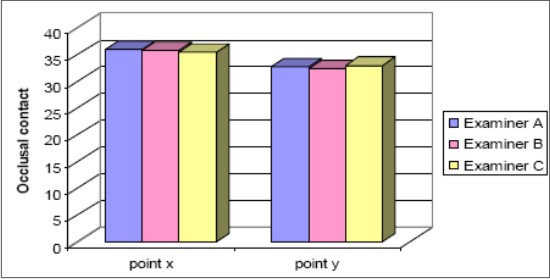Introduction
A simple and reliable means of recording the occlusal contact marks is important not only in relation to clinical dentistry but is also a consideration in dental research. Unless an occlusal record is accurate any change in occlusion cannot be evaluated.
A simple record of occlusal contact marks with a proven reliability could be of value in clinical dentistry as it offers the clinician and dental laboratory technician during a restorative procedure
A study was conducted to record the occlusal contact marks which appears to be quick, simple, and has demonstrated the clinicians to consistently record centric and eccentric occlusal contact marks on an occlusal sketch with high degree of reliability and reproducibility.
Several studies have been done in which acetate sheet was used to record the contact marks.
In a study on occlusal contacts the static and dynamic occlusal contacts of 29 subjects, with no missing functional units, were marked using articulating paper. Three clinicians with varying clinical experience were asked to independently record the marked occlusal contacts using a transparent acetate sheet. The results were analyzed for Kappa agreement for the reliability, and the method was found to be highly reliable[1].
In a study on occlusal contacts, the marked static occlusal contacts of 20 sets of models were recorded in pseudo-clinical situation, by three different dentists and in addition by one dentist on two occasions using a schematic representation of dental arch – the “occlusal sketch”. The median of kappa agreement for inter and intra examiner was almost perfect.[2]
The study was done to determine whether the occlusal sketch technique can be used as a reliable means of verifying the occlusal contacts on articulated casts. Occlusal markings were made on 30 sets of upper and lower dentate casts and these were recorded using the 'occlusal sketch' technique.. The occlusal sketch provided a reliable way of communicating occlusal contacts that occur in a case, between clinician and technician[3]
Objectives
The present study was done with the following objectives,
1. To test the reliability of recording marked occlusal contacts using a transparent acetate sheet.
2. To test whether the occlusal sketch could be used by different clinicians as an accurate method of recording the centric and eccentric occlusal contact marks
Materials and Method
In vivo study was conducted on 30 subjects, the centric and eccentric occlusal contacts were marked using articulating paper (40 micron articulating paper; Bausch articulating paper, Nashua, NH)[4].Ethical clearance was obtained prior doing the study . Three different examiners recorded the marked occlusal contacts using transparent acetate sheet[1], [2], [3]. The results was analyzed Cronbach’s Alpha (statistical analysis).
Method of collection of data [including sampling procedure, if any
The study is planned as follows:
1. Selection of subjects.
2. Recording of occlusal contacts
3. Statistical analysis of the obtained data.
Criteria For Selection
1. No missing teeth
2. No removable prostheses
3. No temporomandibular disorders.
4. No crowns or any type of restorations
5. Subjects with maxillary and mandibular midline coinciding
6. Subjects under age group 18 to 40 years were considered
7. Subjects with group function occlusion
 | Figure no 1 : Occlusal sketch on transparent acetate sheet
 |
 | Figure no 2 : Bausch 40 micron articulating paper
 |
Recording of Occlusal Contacts
The centric and eccentric occlusal contacts was marked using thin articulating paper of 40 micron thickness (Bausch articulating paper, Nashua, NH)[4] (Fig 2). The subjects was placed in the supine position, the teeth were dried and the centric contacts were marked by having subjects to occlude their teeth in centric occlusion by tapping method firmly on blue color articulating paper interposed between the occlusal surfaces of the maxillary and mandibular teeth.
Eccentric contacts were marked in a red color articulating paper (Fig 4) after the subjects made right and left lateral movements of the mandible. Eccentric contacts were recorded in 3mm lateral position as measured at the mandibular midline. This was done by the following method. A line was drawn vertically on the labial surface of the both the upper central incisors with a sharp indelible pencil 3mm on both the side of the midline (Fig 3). The subjects were made to move the mandible laterally till the mandibular midline approximated with the line drawn on the labial surface of the upper central incisors (Fig 5 and Fig 6). This was done in both right and left side.
 | Figure no 3 : A line drawn vertically on the labial surface of the both the upper central incisors with a sharp indelible pencil 3mm on both the side of the midline
 |
 | Figure no 4 : Eccentric contacts were marked in a red color articulating paper
 |
 | Figure no 5 : Right lateral contacts being marked
 |
 | Figure no 6 : left lateral contacts being marked
 |
 | Figure no 7 : Value of contact mark in X and Y-axis being determined
 |
The occlusal sketch[1] (Fig 1) was used to record the occlusal contacts .The sketch consists of an transparent sheet with outline representation of the occlusal aspects of the teeth. The use of transparent sheet in this manner facilitated viewing of the marked occlusal contacts from both the sides It was configured that the mandibular teeth were viewed as if from above by direct vision and the maxillary teeth were mirror image. This is the same view experienced when examining the occlusal surface of a supine patient.
The occlusal contacts on first molars in all the four quadrants were independently recorded using occlusal sketch on the transparent sheet by 3 different examiners.
These occlusal sketches was then analyzed by 1 mm sq grid to enable comparison between different clinicians .Each contact mark was studied for its value in x- axis and y –axis(Fig 7). This technique produced categorical data and therefore Cronbach’s Alpha was used as a test for reliability of repeatability of the marked occlusal sketch for each subject produced by 3 different examiners. Then One way ANOVA test was done for the analysis of variance for comparison between the three examiners.
Results
Three sketches per examiner were obtained i.e., a total of 90 sketches were obtained in 30 patients which consist of 591 centric contacts and 357 eccentric contacts. As the maximum number of contacts was obtained on the first molars so this tooth in all the four quadrants was considered for recording the contact marks on the transparent sheet.
Most of the values for cronbachs alpha scale were above .8 (Table:I) indicating high degree of inter- examiner reliability except for eccentric contacts(Table:II) values in y-axis for examiner B vs C and A vs C in which the value was found to be more than .5 indicating good reliability(Graph-I and Graph II).
Then one way ANOVA was done as an analysis of variance the p values were found to be more than .05(p> 0.05), (Table:III) indicating statistically non significant variance.
 | Table: I- Centric contacts (Cronbach’s Alpha scale)
 |
 | Table: II -Eccentric contacts (Cronbach’s Alpha scale)
 |
 | Table-III- p-values after one way ANOVA
 |
 | GRAPH I: Showing the comparison of the recorded centric contacts by different examiners in x and y-axis.
 |
 | GRAPH II; Showing the comparison of the recorded eccentric contacts by different examiners in x and y-axis
 |
Discussion
Occlusion plays a dominant role in various specialties of dentistry. A healthy occlusion promotes the maintenance of teeth, periodontal ligaments, alveolar bone and temporomandibular joint.
Since dental treatment may potentially change the occlusal contacts, it is essential to have a reliable record of the occlusal contacts of the patient. In addition, complete examination of the dental patient should include the articulatory system, of which the occlusion is an important element.
The results obtained in this study were similar to the study done by Davies et al[1],[2],[3]
The present study has demonstrated that the prosthodontist and other clinicians are able to consistently record the marked occlusal contacts on a transparent acetate sheet with high degree of reliability. The cronbachs alpha statistical analysis has showed that this technique used permits different operators to reliably and consistently record the occlusal contacts.
Conclusion
This in-vivo study suggests that the occlusal sketch is a system which is quick, simple means of recording centric and eccentric contacts marks with high degree of precision and reproducibility.
It can be used as a reliable method in recording occlusal contacts by various clinicians during restorative procedures.
Also the data can be transferred and stored for various clinical and lab procedures by different clinicians and also the recorded contact marks can be analyzed at different stages of dental procedures.
The data can be easily transferred from clinicians to the lab technicians3 for various restorative procedures in the fabrication of the indirect restorations.
References
1. Stephen Davies, Ziad Al-Ani, Huw Jeremiah, Daniel Winston, Philip Smith Reliability of recording static and dynamic occlusal contact marks using transparent acetate sheet. J Posthet dent 2005; 94:458-461
2. Davies SJ, Gray RJ, Al-Ani MZ, Sloan P, Worthington H. Inter- and intraoperator reliability of the recording of occlusal contacts using occlusal sketch acetate technique. Br Dent J 2002; 193:397-400.
3. Davies SJ, Al-Ani Z, Richmond R, Worthington HV, Smith PW 'Occlusal sketch'; a reliable technique for technicians to check that the occlusion of models is correct. Eur J Prosthodont Restor Dent. 2005 Jun; 13(2):65-8
4. Carossa S, Lojacono A, Schierano G, Pera P. Evaluation of occlusal contacts in the dental laboratory: influence of strip thickness and operator experience. Int J Prosthodont. 2000 May-Jun; 13(3):201-4.
|